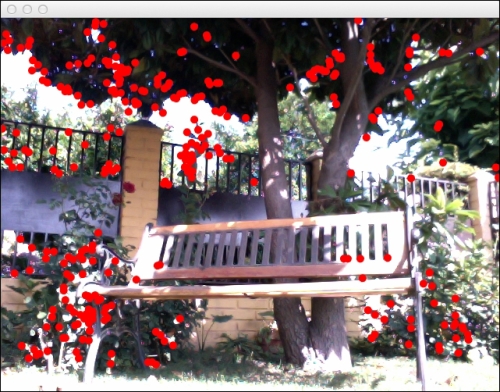In this recipe we will learn how to track motion in the images produced from a webcam using OpenCV using the popular Lucas Kanade optical flow algorithm.
We will need to use OpenCV in this recipe, so please refer to the Integrating with OpenCV recipe from Chapter 3, Using Image Processing Techniques and add OpenCV and it's CinderBlock to your project. Include the following files to your source file:
#include "cinder/Capture.h" #include "cinder/gl/Texture.h" #include "CinderOpenCV.h"
Add the following using statements:
using namespace ci; using namespace ci::app; using namespace std;
We will read frames from the camera and track motion.
- Declare the
ci::gl::Textureandci::Captureobjects to display and capture from a camera. Also, declare acv::Matobject as the previous frame, twostd::vector<cv::Point2f>objects to store the current and previous features, and astd::vector<uint8_t>object to store the status of each feature:gl::Texture mTexture; Capture mCamera; cv::Mat mPreviousFrame; vector< cv::Point2f > mPreviousFeatures, mFeatures; vector< uint8_t > mFeatureStatuses; - In the
setupmethod we will initializemCamera:try{ mCamera = Capture( 640, 480 ); mCamera.start(); } catch( ... ){ console() << "unable to initialize device" << endl; } - In the
updatemethod we need to check ifmCamerahas been correctly initialized and whether it has a new frame available:if( mCamera ){ if( mCamera.checkNewFrame() ){ - After those
ifstatements we will get a reference toci::SurfaceofmCameraand then copy it to ourmTexturefor drawing:Surface surface = mCamera.getSurface(); mTexture = gl::Texture( surface ); - Now let's create a
cv::Matwith the current camera frame. We will also check ifmPreviousFramecontains any initialized data, calculate the good features to track, and calculate their motion from the previous camera frame to the current frame:cv::Mat frame( toOcv( Channel( surface ) ) ); if( mPreviousFrame.data != NULL ){ cv::goodFeaturesToTrack( frame, mFeatures, 300, 0.005f, 3.0f ); vector<float> errors; mPreviousFeatures = mFeatures; cv::calcOpticalFlowPyrLK( mPreviousFrame, frame, mPreviousFeatures, mFeatures, mFeatureStatuses, errors ); } - Now we just need to copy the frame to
mPreviousFrameand close the initialifstatements:mPreviousFrame = frame; } } - In the
drawmethod we will begin by clearing the background with black and drawingmTexture:gl::clear( Color( 0, 0, 0 ) ); if( mTexture ){ gl::color( Color::white() ); gl::draw( mTexture, getWindowBounds() ); } - Next, we will draw red lines on the features we have tracked, using
mFeatureStatusto draw the features that have been matched:glColor4f( 1.0f, 0.0f, 0.0f, 1.0f ); for( int i=0; i<mFeatures.size(); i++ ){ if( (bool)mFeatureStatuses[i] == false ) continue; gl::drawSolidCircle( fromOcv( mFeatures[i] ), 5.0f ); } - Finally, we will draw a line between the previous features and the current ones, also using
mFeatureStatusto draw one of the features that has been matched:for( int i=0; i<mFeatures.size(); i++ ){ if( (bool)mFeatureStatuses[i] == false ) continue; Vec2f pt1 = fromOcv( mFeatures[i] ); Vec2f pt2 = fromOcv( mPreviousFeatures[i] ); gl::drawLine( pt1, pt2 ); }In the following image, the red dots represent good features to track:

The optical flow algorithm will make an estimation of how much the tracked point has moved from one frame to the other.
In this recipe we are using the cv::goodFeaturesToTrack object to calculate which features are optimal for tracking, but it is also possible to manually choose which points we wish to track. All we have to do is populate mFeatures manually with whatever points we wish to track and pass it to the cv::calcOpticalFlowPyrLK. object
